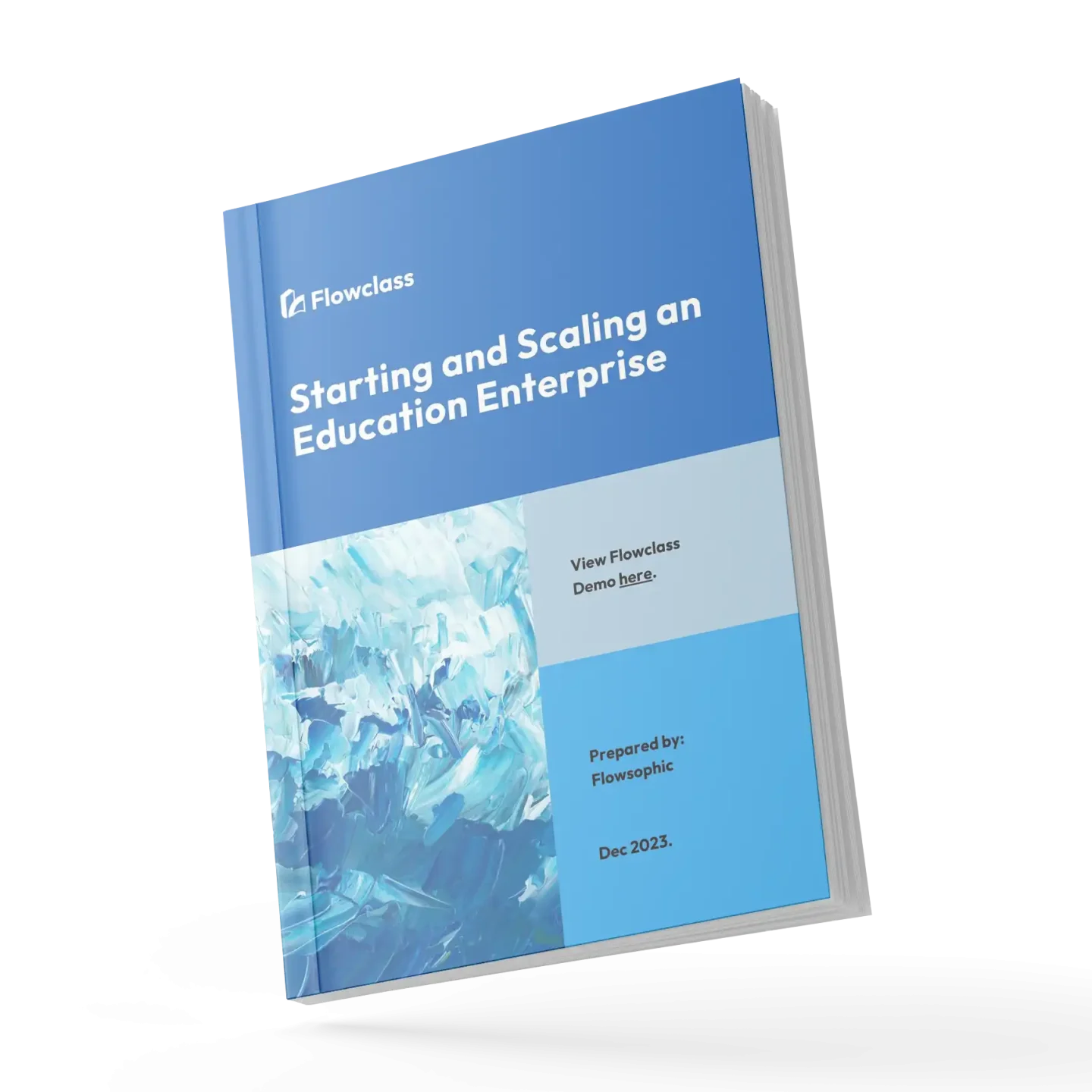The education landscape has changed dramatically, with tutoring classes online becoming the go-to choice for students and educators. With the right setup, an online tutoring business can offer flexibility, scalability, and an engaging learning experience for students worldwide. In this guide, we will walk you through how to establish a successful virtual learning business, covering everything from choosing a niche to scaling your operations.

Why Start Tutoring Classes Online?
The demand for online education has surged due to advancements in technology and the need for accessible learning options. More students and parents are now seeking digital solutions that offer convenience and flexibility without compromising the quality of education. Here are some key reasons why launching an online tutoring business is a great idea:
Flexibility
Online tutoring allows instructors to teach from anywhere, providing convenience and work-life balance. Whether you are a full-time educator or looking for a side income, online tutoring lets you create your own schedule and work at your own pace.
Scalability:
With digital platforms, tutors can expand their reach beyond local students to a global audience. Unlike traditional tutoring, where your student base is limited to your location, online tutoring allows you to teach students from different countries and time zones.
Cost-Effective:
Running an online tutoring business eliminates expenses related to physical locations and commute costs. Tutors do not need to rent office spaces or travel, reducing operational costs significantly.
Customized Learning:
Tutors can personalize lessons to meet the needs of each student, leading to improved learning outcomes. With online tools and analytics, educators can monitor student progress and adapt their teaching methods accordingly.

Steps to Launching a Successful Online Tutoring Business
1. Identify Your Niche and Target Audience
Before setting up tutoring classes online, define your area of expertise and the students you want to serve. Identifying a niche helps in targeting the right audience and setting yourself apart from competitors. Consider the following:
- Academic subjects (math, science, languages, etc.)
- Test preparation (SAT, GRE, IELTS, etc.)
- Skill-based learning (coding, music, public speaking, etc.)
- Age group (school students, college learners, professionals)
Focusing on a specific niche helps you tailor your teaching approach and marketing strategies. Specializing in a particular subject or skill makes it easier to build authority in that domain and attract students who are looking for expertise in that area.
2. Choose the Right Online Tutoring Platform
Selecting a reliable platform is crucial for delivering seamless tutoring sessions. Your platform should provide an engaging and smooth experience for both students and tutors. Some key features to look for include:
- Interactive whiteboards for better explanations
- Video conferencing with screen-sharing capabilities
- Secure payment processing for hassle-free transactions
- Session recording capabilities for student revision
- Student progress tracking for performance analysis
A great option to explore is Flowclass, a platform designed for education businesses, offering automation tools and efficient student management. It integrates multiple features that make running an online tutoring business easier and more effective.
3. How Flowclass Helps in Setting Up Online Tutoring
Flowclass is a powerful platform designed to simplify and automate various aspects of running tutoring classes online. Here’s how it helps:
Automated Student Enrollment:
Flowclass streamlines student registration, reducing manual efforts and ensuring a seamless onboarding process. Tutors can save time and focus on teaching instead of handling administrative work.
Multi-Channel Payment Reminders:
Tutors can automate payment follow-ups, ensuring timely fee collection without the hassle of manual tracking. This helps maintain consistent revenue without uncomfortable payment reminders to students or parents.
One-Click Receipt Processing:
Generate and send receipts instantly to students or parents, maintaining transparency and efficient record-keeping. This feature simplifies accounting and financial management for tutors.
Event Check-In with QR Codes:
If you conduct live workshops or special online sessions, Flowclass enables smooth event management and check-ins. This is useful for tutors who offer webinars or additional learning events.
Student CRM for Personalized Learning:
Track student progress, manage communication, and provide customized feedback to enhance learning experiences. This allows tutors to create an individualized approach for each student, improving learning outcomes.
By leveraging these automation tools, tutors can focus on teaching while Flowclass takes care of the operational aspects, making online tutoring more efficient and less stressful.
Example: A group of language tutors offering online Spanish lessons adopted Flowclass to handle student enrollments, automated payments, and lesson scheduling.
Within months, they reduced administrative workload by 70%, allowing them to focus on improving course content and student engagement.
Discover more on how automation enhances online education at EdTech Magazine.
4. Create a Structured Curriculum
A well-organized curriculum enhances learning efficiency and ensures that students receive structured guidance. Without a clear plan, students may struggle to follow lessons, leading to disengagement. Design your courses with the following in mind:
- Clear learning objectives to set expectations from the beginning
- Engaging lesson plans to keep students interested and motivated
- Multimedia resources (videos, quizzes, slides, etc.) to enhance understanding
- Assessments and quizzes to track progress and reinforce learning
Having a structured approach ensures students receive consistent and high-quality instruction, leading to better results.
Example: James, an experienced coding tutor, structured his Python programming course into beginner, intermediate, and advanced levels. By using video tutorials, live coding sessions, and interactive quizzes, he kept students engaged and improved completion rates by 80%. Explore free Python resources at W3Schools.

5. Set Up Your Tutoring Space and Equipment
To maintain professionalism and deliver high-quality lessons, invest in a high-quality setup, including:
- A reliable computer or tablet with sufficient processing power
- A high-speed internet connection to prevent disruptions
- A quality microphone and webcam for clear audio and video communication
- Proper lighting and a distraction-free background to maintain professionalism
A professional setup not only improves lesson delivery but also enhances student engagement and overall learning experience.
Example: An English tutor, Lisa, used YouTube to provide free grammar tips and attracted thousands of students to her paid courses. By leveraging video content and social media, she tripled her student base within six months. Read more on video marketing for educators at HubSpot.
6. Market Your Online Tutoring Business
Growing your online tutoring business requires strategic marketing efforts. Without a solid marketing plan, even the best tutoring services may struggle to attract students. Here are effective ways to reach your target audience:
- SEO and Content Marketing: Write blogs and create videos around tutoring topics to drive traffic to your website.
- Social Media Advertising: Promote your services on platforms like Facebook, Instagram, and LinkedIn.
- Referral Programs: Offer incentives for students who bring in new learners.
- Partnerships: Collaborate with schools or education influencers to increase visibility.
7. Offer Free Demo Classes
Providing a free trial session helps potential students experience your teaching style before committing. This increases trust and conversion rates, making it easier to attract new students.
For example: Skillshare provides a one-week free trial for new users, allowing them to explore various courses before committing to a subscription.
8. Engage Students with Interactive Learning Tools
Tutoring classes online should be engaging and interactive. Incorporate the following:
- Gamification techniques for motivation
- Real-time quizzes to test knowledge
- Group discussions and peer learning to encourage collaboration
- AI-powered personalized recommendations to help students focus on weak areas
Using engaging teaching methods keeps students motivated and improves retention rates, ensuring they stay enrolled in your courses longer.
9. Optimize Pricing and Payment Options
Determine a competitive pricing model based on your niche, experience, and market demand. Consider offering multiple pricing plans:
- Hourly rates vs. package-based pricing for flexibility
- Discounts for long-term enrollments to encourage commitment
- Subscription-based learning plans for ongoing courses
- Flexible payment methods (credit cards, PayPal, digital wallets) for easy transactions
With Flowclass, you can automate invoicing and manage different pricing plans effortlessly, saving time and ensuring smooth transactions.
Final Thoughts
Setting up tutoring classes online is a rewarding venture that allows educators to share their expertise with a global audience. By following these steps—choosing the right platform, structuring your curriculum, engaging students, and scaling strategically—you can build a successful and sustainable virtual learning business with Flowclass.


